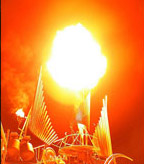 We’re all familiar with the usual panoply of instruments: plucked strings amplified by a guitar’s hollow wooden body, air oscillating in a flute’s cylindrical tube, metal bells resonating when struck. But there are surprising ways to make music utilizing unusual sources — the elements themselves: fire, water, the earth beneath our feet, and the air around us.
We’re all familiar with the usual panoply of instruments: plucked strings amplified by a guitar’s hollow wooden body, air oscillating in a flute’s cylindrical tube, metal bells resonating when struck. But there are surprising ways to make music utilizing unusual sources — the elements themselves: fire, water, the earth beneath our feet, and the air around us.
 FIRE. Pyrophones, or fire organs, are musical instruments sounded by explosions, fire, rapid combustion, rapid heating, and other thermoacoustic devices. Oddstrument has several videos of a gas-powered fire organ created by the London-based science and art collective Experiment 1, and Hubbub Music’s “Pyrophone Juggernaut.” Based on an experimental instrument from the 1700s, the Pyrophone Juggernaut produces sounds that are described as “deep growls, atavistic moans, and even choral sounding timbres… with epic bell chords, industrial drums and acoustic bass.”
FIRE. Pyrophones, or fire organs, are musical instruments sounded by explosions, fire, rapid combustion, rapid heating, and other thermoacoustic devices. Oddstrument has several videos of a gas-powered fire organ created by the London-based science and art collective Experiment 1, and Hubbub Music’s “Pyrophone Juggernaut.” Based on an experimental instrument from the 1700s, the Pyrophone Juggernaut produces sounds that are described as “deep growls, atavistic moans, and even choral sounding timbres… with epic bell chords, industrial drums and acoustic bass.”
 WATER. One of the ways that women and girls of the Baka Forest People in Cameroon make music is literally to “play the river.” Standing waist-high in the river, they hit the surface of the water with cupped hands, each person playing a different rhythmic pattern that together form a more complex syncopated rhythm. Water also provides the source of music for wave organs, which use the motion of ocean waves and tides to produce sounds. Oddstrument describes three interesting examples at seashore locations in Zabar, Croatia; Blackpool, England; and San Francisco. The suikinkutsu, literally meaning “water harp chamber,” is an underground Japanese water instrument usually located in temple gardens. An upside down pot is buried underground, with a porous rock layer above and an impermeable layer below. Water dripping into the chamber creates a pleasant ringing sound.
WATER. One of the ways that women and girls of the Baka Forest People in Cameroon make music is literally to “play the river.” Standing waist-high in the river, they hit the surface of the water with cupped hands, each person playing a different rhythmic pattern that together form a more complex syncopated rhythm. Water also provides the source of music for wave organs, which use the motion of ocean waves and tides to produce sounds. Oddstrument describes three interesting examples at seashore locations in Zabar, Croatia; Blackpool, England; and San Francisco. The suikinkutsu, literally meaning “water harp chamber,” is an underground Japanese water instrument usually located in temple gardens. An upside down pot is buried underground, with a porous rock layer above and an impermeable layer below. Water dripping into the chamber creates a pleasant ringing sound.
 EARTH. Another unusual instrument of the Baka Forest People is the angbindi, or earth bow, a single string instrument connected to a pliable sappling that uses the earth as a sounding board. In Japan, several roads have been built by the Hokkaido Industrial Research Institute with rows of grooves that, when driven over at a certain speed (28mph), play a tune. Deputy Dog has posted a link for listening to the musical roadway.
EARTH. Another unusual instrument of the Baka Forest People is the angbindi, or earth bow, a single string instrument connected to a pliable sappling that uses the earth as a sounding board. In Japan, several roads have been built by the Hokkaido Industrial Research Institute with rows of grooves that, when driven over at a certain speed (28mph), play a tune. Deputy Dog has posted a link for listening to the musical roadway.
 AIR. Aeolian harps, named after Aeolus, the Greek god of wind, are harps dating from ancient times that were designed to be played by the wind rather than by humans. The Bible mentions such a harp that King David held up to be played by the North wind at midnight. Around 800 B.C., Homer describes how Hermes stretched dried sinews across a turtle shell and held it up to the wind. Aeolian harps became popular in Europe during the Romantic era. The strings were stretched inside a box with carved openings, a construction that is still used today.
AIR. Aeolian harps, named after Aeolus, the Greek god of wind, are harps dating from ancient times that were designed to be played by the wind rather than by humans. The Bible mentions such a harp that King David held up to be played by the North wind at midnight. Around 800 B.C., Homer describes how Hermes stretched dried sinews across a turtle shell and held it up to the wind. Aeolian harps became popular in Europe during the Romantic era. The strings were stretched inside a box with carved openings, a construction that is still used today.
These are just several examples of unorthodox ways to produce music.
